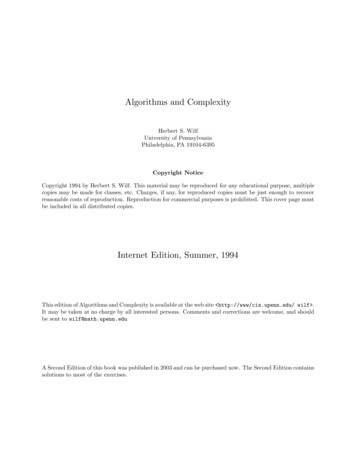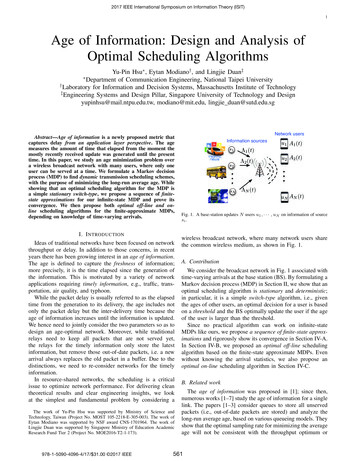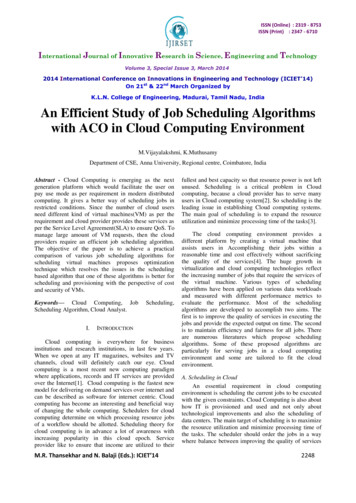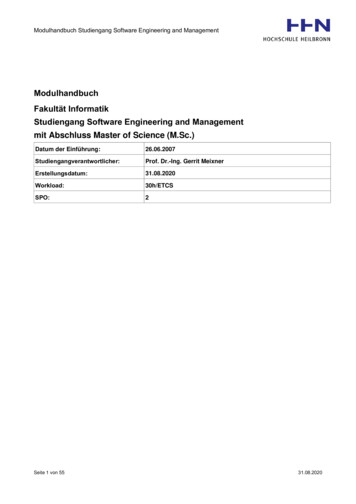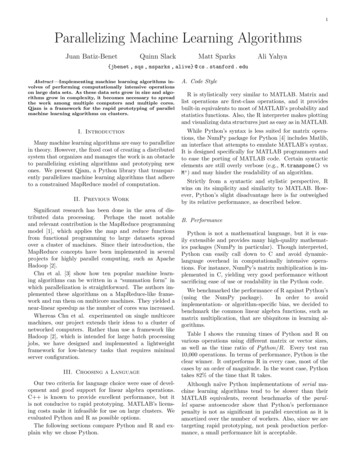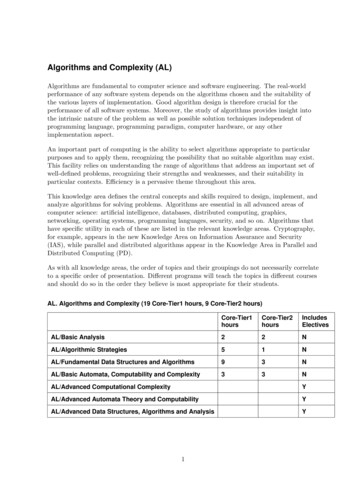
Transcription
Algorithms and Complexity (AL)Algorithms are fundamental to computer science and software engineering. The real-worldperformance of any software system depends on the algorithms chosen and the suitability ofthe various layers of implementation. Good algorithm design is therefore crucial for theperformance of all software systems. Moreover, the study of algorithms provides insight intothe intrinsic nature of the problem as well as possible solution techniques independent ofprogramming language, programming paradigm, computer hardware, or any otherimplementation aspect.An important part of computing is the ability to select algorithms appropriate to particularpurposes and to apply them, recognizing the possibility that no suitable algorithm may exist.This facility relies on understanding the range of algorithms that address an important set ofwell-defined problems, recognizing their strengths and weaknesses, and their suitability inparticular contexts. Efficiency is a pervasive theme throughout this area.This knowledge area defines the central concepts and skills required to design, implement, andanalyze algorithms for solving problems. Algorithms are essential in all advanced areas ofcomputer science: artificial intelligence, databases, distributed computing, graphics,networking, operating systems, programming languages, security, and so on. Algorithms thathave specific utility in each of these are listed in the relevant knowledge areas. Cryptography,for example, appears in the new Knowledge Area on Information Assurance and Security(IAS), while parallel and distributed algorithms appear in the Knowledge Area in Parallel andDistributed Computing (PD).As with all knowledge areas, the order of topics and their groupings do not necessarily correlateto a specific order of presentation. Different programs will teach the topics in different coursesand should do so in the order they believe is most appropriate for their students.AL. Algorithms and Complexity (19 Core-Tier1 hours, 9 Core-Tier2 vesAL/Basic Analysis22NAL/Algorithmic Strategies51NAL/Fundamental Data Structures and Algorithms93NAL/Basic Automata, Computability and Complexity33NAL/Advanced Computational ComplexityYAL/Advanced Automata Theory and ComputabilityYAL/Advanced Data Structures, Algorithms and AnalysisY1
AL/Basic Analysis[2 Core-Tier1 hours, 2 Core-Tier2 hours]Topics:[Core-Tier1] Differences among best, expected, and worst case behaviors of an algorithmAsymptotic analysis of upper and expected complexity boundsBig-O notation: formal definition and useAlgorithms with various time and space complexity such as constant, logarithmic, linear,quadratic, and exponentialEmpirical measurements of performanceTime and space trade-offs in algorithms[Core-Tier2] Big-O notation: useLittle-o, big-Omega and big-Theta notationRecurrence relationsAnalysis of iterative and recursive algorithmsSolving recurrence relationsLearning outcomes:[Core-Tier1]1. Explain what is meant by “best”, “expected”, and “worst” case behavior of an algorithm.[Familiarity]2. In the context of specific algorithms, identify the characteristics of data and/or other conditionsor assumptions that lead to different behaviors. [Assessment]3. Determine informally the time and space complexity of simple algorithms. [Usage]4. State the formal definition of the big-O notation. [Familiarity]5. List and contrast standard complexity classes. [Familiarity]6. Perform empirical studies to validate hypotheses about runtime stemming from mathematicalanalysis. Run algorithms on inputs of various sizes and compare performance. [Assessment]7. Give examples that illustrate time-space trade-offs of algorithms. [Familiarity][Core-Tier2]8. Use big-O notation formally to give asymptotic upper bounds on time and space complexity ofalgorithms. [Usage]9. Use big-O notation formally to give bounds on expected time complexity of algorithms. [Usage]10. Explain the use of big-Omega, big-Theta, and little-o notation to describe the amount of workdone by an algorithm. [Familiarity]11. Use recurrence relations to determine the time complexity of recursively defined algorithms.[Usage]12. Solve elementary recurrence relations. [Usage]AL/Algorithmic Strategies[5 Core-Tier1 hours, 1 Core-Tier2 hour]An instructor might choose to cover these algorithmic strategies in the context of thealgorithms presented in “Fundamental Data Structures and Algorithms” below. While the2
total number of hours for the two knowledge units (18) could be divided differently betweenthem, our sense is that the 1:2 ratio is reasonable.Topics:[Core-Tier1] Brute-force algorithmsGreedy algorithmsDivide-and-conquer (cross-reference SDF/Algorithms and Design/Problem-solving strategies)Recursive backtrackingDynamic programming[Core-Tier2] Branch-and-boundHeuristicsReduction: transform-and-conquerLearning outcomes:[Core-Tier1]1. For each of the strategies (brute-force, greedy, divide-and-conquer, recursive backtracking, anddynamic programming), identify a practical example to which it would apply. [Familiarity]2. Use a greedy approach to solve an appropriate problem and determine if the greedy rule chosenleads to an optimal solution. [Assessment]3. Use a divide-and-conquer algorithm to solve an appropriate problem. [Usage]4. Use recursive backtracking to solve a problem such as navigating a maze. [Usage]5. Use dynamic programming to solve an appropriate problem. [Usage]6. Determine an appropriate algorithmic approach to a problem. [Assessment][Core-Tier2]7.8.9.10.Describe various heuristic problem-solving methods. [Familiarity]Use a heuristic approach to solve an appropriate problem. [Usage]Describe the trade-offs between brute force and heuristic strategies. [Assessment]Describe how a branch-and-bound approach may be used to improve the performance of aheuristic method. [Familiarity]AL/Fundamental Data Structures and Algorithms[9 Core-Tier1 hours, 3 Core-Tier2 hours]This knowledge unit builds directly on the foundation provided by Software DevelopmentFundamentals (SDF), particularly the material in SDF/Fundamental Data Structures andSDF/Algorithms and Design.Topics:[Core-Tier1] Simple numerical algorithms, such as computing the average of a list of numbers, finding theminimum, maximum, and mode in a list, approximating the square root of a number, or findingthe greatest common divisorSequential and binary search algorithms3
Worst case quadratic sorting algorithms (selection, insertion)Worst or average case O(N log N ) sorting algorithms (quicksort, heapsort, mergesort)Hash tables, including strategies for avoiding and resolving collisionsBinary search trees Operations on binary search trees: search, insert, and deleteGraphs and graph algorithms Representations of graphs (e.g., adjacency list, adjacency matrix) Depth- and breadth-first traversals[Core-Tier2] HeapsGraphs and graph algorithms Shortest-path algorithms (Dijkstra’s and Floyd’s algorithms) Minimum spanning tree (Prim’s and Kruskal’s algorithms)Pattern matching and string/text algorithms (e.g., substring matching, regular expressionmatching, longest common subsequence algorithms)Learning outcomes:[Core-Tier1]1. Implement basic numerical algorithms. [Usage]2. Implement simple search algorithms and explain the differences in their time complexities.[Assessment]3. Be able to implement common quadratic and O(N log N ) sorting algorithms. [Usage]4. Describe the implementation of hash tables, including collision avoidance and resolution.[Familiarity]5. Discuss the runtime and memory efficiency of principal algorithms for sorting, searching, andhashing. [Familiarity]6. Discuss factors other than computational efficiency that influence the choice of algorithms, suchas programming time, maintainability, and the use of application-specific patterns in the inputdata. [Familiarity]7. Explain how tree balance affects the efficiency of various binary search tree operations.[Familiarity]8. Solve problems using fundamental graph algorithms, including depth-first and breadth-firstsearch. [Usage]9. Demonstrate the ability to evaluate algorithms, to select from a range of possible options, toprovide justification for that selection, and to implement the algorithm in a particular context.[Assessment][Core-Tier2]10. Describe the heap property and the use of heaps as an implementation of priority queues.[Familiarity]11. Solve problems using graph algorithms, including single-source and all-pairs shortest paths, andat least one minimum spanning tree algorithm. [Usage]12. Trace and/or implement a string-matching algorithm. [Usage]4
AL/Basic Automata, Computability and Complexity[3 Core-Tier1 hours, 3 Core-Tier2 hours]Topics:[Core-Tier1] Finite-state machinesRegular expressionsComputabilityThe halting problem[Core-Tier2] Context-free grammars (cross-reference PL/Syntax Analysis)Introduction to the classes P and NP, and the P vs. NP problemIntroduction to the notion of NP-completeness and exemplary NP-complete problems (e.g., thesatisfiability problem, knapsack problem)Learning outcomes:[Core-Tier1]1.2.3.4.Discuss the concept of finite state machines. [Familiarity]Design a deterministic finite state machine to accept a specified language. [Usage]Generate a regular expression to represent a specified language. [Usage]Explain why the halting problem has no algorithmic solution. [Familiarity][Core-Tier2]5. Design a context-free grammar to represent a specified language. [Usage]6. Define the classes P and NP. [Familiarity]7. Explain the significance of NP-completeness. [Familiarity]AL/Advanced Computational Complexity[Elective]Topics: Review of the classes P and NP, introduction to the classes PSPACE and EXPPolynomial hierarchyNP-completeness (Cook’s theorem)Classic NP-complete problemsReduction techniquesLearning outcomes:1. Define the classes P and NP. (Also appears in AL/Basic Automata, Computability andComplexity). [Familiarity]2. Define the class PSPACE and its relation to the class EXP. [Familiarity]3. Explain the significance of NP-completeness. (Also appears in AL/Basic Automata,Computability and Complexity). [Familiarity]4. Provide examples of classic NP-complete problems. [Familiarity]5. Prove that a problem is NP-complete by reducing a known NP-complete problem to it. [Usage]5
AL/Advanced Automata Theory and Computability[Elective]Topics: Sets and languages Regular languages Review of deterministic finite automata (DFAs) Nondeterministic finite automata (NFAs) Equivalence of DFAs and NFAs Review of regular expressions; their equivalence to finite automata Closure properties Proving languages non-regular, via the pumping lemma or alternative meansContext-free languages Push-down automata (PDAs) Relationship of PDAs and context-free grammars Properties of context-free languagesTuring machines, or an equivalent formal model of universal computationNondeterministic Turing machinesChomsky hierarchyThe Church-Turing thesisRice’s TheoremExamples of uncomputable functionsImplications of uncomputabilityLearning outcomes:1. Determine a language’s place in the Chomsky hierarchy (regular, context-free, recursivelyenumerable). [Assessment]2. Convert among equivalently powerful notations for a language, including among DFAs, NFAs,and regular expressions, and between PDAs and CFGs. [Usage]3. Explain the Church-Turing thesis and its significance. [Familiarity]4. Explain Rice’s Theorem and its significance. [Familiarity]5. Provide examples of uncomputable functions. [Familiarity]6. Prove that a problem is uncomputable by reducing a known uncomputable problem to it.[Usage]AL/Advanced Data Structures, Algorithms and Analysis[Elective]Many programs will want their students to have exposure to more advanced algorithms ormethods of analysis. Below is a selection of possible advanced topics that are current andtimely but by no means exhaustive.Topics: Balanced trees (e.g., AVL trees, red-black trees, splay trees, treaps)Graphs (e.g., topological sort, finding strongly connected components, matching)Advanced data structures (e.g., B-trees, Fibonacci heaps)String-based data structures and algorithms (e.g., suffix arrays, suffix trees, tries)Network flows (e.g., max flow [Ford-Fulkerson algorithm], max flow – min cut, maximumbipartite matching)Linear Programming (e.g., duality, simplex method, interior point algorithms)6
Number-theoretic algorithms (e.g., modular arithmetic, primality testing, integer factorization)Geometric algorithms (e.g., points, line segments, polygons [properties, intersections], findingconvex hull, spatial decomposition, collision detection, geometric search/proximity)Randomized algorithmsStochastic algorithmsApproximation algorithmsAmortized analysisProbabilistic analysisOnline algorithms and competitive analysisDistributed algorithms (cross-reference PD/Distributed Systems)Parallel algorithms (cross-reference PD/Parallel Algorithms, Analysis, and Programming)Cryptographic algorithms (cross-reference IAS/Cryptography)Learning outcomes:1. Understand the mapping of real-world problems to algorithmic solutions (e.g., as graphproblems, linear programs, etc.). [Assessment]2. Select and apply advanced algorithmic techniques (e.g., randomization, approximation) to solvereal problems. [Assessment]3. Select and apply advanced analysis techniques (e.g., amortized, probabilistic, etc.) toalgorithms. [Assessment]7
Architecture and Organization (AR)Computing professionals should not regard the computer as just a black box that executesprograms by magic. The knowledge area Architecture and Organization builds on SystemsFundamentals (SF) to develop a deeper understanding of the hardware environment uponwhich all computing is based, and the interface it provides to higher software layers. Studentsshould acquire an understanding and appreciation of a computer system’s functionalcomponents, their characteristics, performance, and interactions, and, in particular, thechallenge of harnessing parallelism to sustain performance improvements now and into thefuture. Students need to understand computer architecture to develop programs that canachieve high performance through a programmer’s awareness of parallelism and latency. Inselecting a system to use, students should be able to understand the tradeoff among variouscomponents, such as CPU clock speed, cycles per instruction, memory size, and averagememory access time.The learning outcomes specified for these topics correspond primarily to the core and areintended to support programs that elect to require only the minimum 16 hours of computerarchitecture of their students. For programs that want to teach more than the minimum, thesame AR topics can be treated at a more advanced level by implementing a two-coursesequence. For programs that want to cover the elective topics, those topics can be introducedwithin a two-course sequence and/or be treated in a more comprehensive way in a third course.AR. Architecture and Organization (0 Core-Tier1 hours, 16 Core-Tier2 hours)Core-Tier2hoursIncludesElectivesAR/Digital Logic and Digital Systems3NAR/Machine Level Representation of Data3NAR/Assembly Level Machine Organization6NAR/Memory System Organization and Architecture3NAR/Interfacing and Communication1NCore-Tier1hoursAR/Functional OrganizationYAR/Multiprocessing and Alternative ArchitecturesYAR/Performance EnhancementsYAR/Digital Logic and Digital Systems[3 Core-Tier2 hours]Cross-reference: SF/Computational ParadigmsStudents are strongly recommended to learn “SF/Computational Paradigms” before this unit.SF/Computational Paradigms will be taught ahead of this unit in most of institutions.8
Topics: Combinational vs. sequential logic/Field programmable gate arrays as a fundamentalcombinational sequential logic building blockMultiple representations/layers of interpretation (hardware is just another layer)Computer-aided design tools that process hardware and architectural representationsRegister transfer notation/Hardware Description Language (Verilog/VHDL)Physical constraints (gate delays, fan-in, fan-out, energy/power)Learning outcomes:1. Comprehend the trend of modern computer architectures towards multi-core and thatparallelism is inherent in all hardware systems. [Familiarity]2. Explain the implications of the “power wall” in terms of further processor performanceimprovements and the drive towards harnessing parallelism. [Familiarity]3. Articulate that there are many equivalent representations of computer functionality, includinglogical expressions and gates, and be able to use mathematical expressions to describe thefunctions of simple combinational and sequential logic. [Familiarity]4. Design the basic building blocks of a computer: arithmetic-logic unit (gate-level), registers(gate-level), central processing unit (register transfer-level), memory (register transfer-level).[Usage]5. Use CAD tools for capture, synthesis, and simulation to evaluate simple building blocks (e.g.,arithmetic-logic unit, registers, movement between registers) of a simple computer design.[Usage]6. Evaluate the functional and timing diagram behavior of a simple processor implemented at thelogic circuit level. [Assessment]AR/Machine Level Representation of Data[3 Core-Tier2 hours]Topics: Bits, bytes, and wordsNumeric data representation and number basesFixed- and floating-point systemsSigned and twos-complement representationsRepresentation of non-numeric data (character codes, graphical data)Representation of records and arraysLearning outcomes:1. Explain why everything is data, including instructions, in computers. [Familiarity]2. Explain the reasons for using alternative formats to represent numerical data. [Familiarity]3. Describe how negative integers are stored in sign-magnitude and twos-complementrepresentations. [Familiarity]4. Explain how fixed-length number representations affect accuracy and precision. [Familiarity]5. Describe the internal representation of non-numeric data, such as characters, strings, records,and arrays. [Familiarity]6. Convert numerical data from one format to another. [Usage]7. Write simple programs at the assembly/machine level for string processing and manipulation.[Usage]9
AR/Assembly Level Machine Organization[6 Core-Tier2 hours]Topics: Instruction set architecture (ISA)Basic organization of the stored program computerBasic control sequences of the stored program computer: instruction fetch, decode, andexecutionInstruction sets and types (data manipulation, control, I/O)Assembly/machine language programmingInstruction formatsAddressing modesSubroutine call and return mechanisms (cross-reference PL/Language Translation andExecution)I/O and interruptsHeap vs. Static vs. Stack vs. Code segmentsmultiprocessors/multicore Shared memory organizationIntroduction to SIMD vs. MIMD and the Flynn TaxonomyLearning outcomes:1. Explain the organization of the stored program computer and its major functional units.[Familiarity]2. Describe how an instruction is executed in a stored program computer, with extensions forthreads, multiprocessor synchronization, and SIMD execution. [Familiarity]3. Describe instruction level parallelism and hazards, and how they are managed in typicalprocessor pipelines. [Familiarity]4. Summarize how instructions are represented at both the machine level and in the context of asymbolic assembler. [Familiarity]5. Demonstrate how to map between high-level language patterns into assembly/machine languagenotations. [Familiarity]6. Explain different instruction formats, such as addresses per instruction and variable length vs.fixed length formats. [Familiarity]7. Explain how subroutine calls are handled at the assembly level. [Familiarity]8. Explain the basic concepts of interrupts and I/O operations. [Familiarity]9. Write simple assembly language program segments. [Usage]10. Show how fundamental high-level programming constructs are implemented at themachine-language level. [Usage]AR/Memory System Organization and Architecture[3 Core-Tier2 hours]Cross-reference: OS/Memory ManagementTopics: Storage systems and their technologyMemory hierarchy: importance of temporal and spatial localityMain memory organization and operationsLatency, cycle time, bandwidth, and interleavingCache memories (address mapping, block size, replacement and store policy)Multiprocessor cache consistency/Using the memory system for inter-core10
synchronization/atomic memory operationsVirtual memory (page table, TLB)Fault handling and reliabilityError coding, data compression, and data integrity (cross-reference SF/Reliability throughRedundancy)Learning outcomes:1. Identify the main types of memory technology (e.g., SRAM, DRAM, Flash, magnetic disk) andtheir relative cost and performance. [Familiarity]2. Explain the effect of memory latency on running time. [Familiarity]3. Describe how the use of memory hierarchy (cache, virtual memory) is used to reduce theeffective memory latency. [Familiarity]4. Describe the principles of memory management. [Familiarity]5. Explain the workings of a system with virtual memory management. [Familiarity]6. Compute Average Memory Access Time under a variety of cache and memory configurationsand mixes of instruction and data references. [Usage]AR/Interfacing and Communication[1 Core-Tier2 hour]Cross-reference: Operating Systems (OS) Knowledge Area for a discussion of the operatingsystem view of input/output processing and management. The focus here is on the hardwaremechanisms for supporting device interfacing and processor-to-processor communications.Topics: I/O fundamentals: handshaking, buffering, programmed I/O, interrupt-driven I/OInterrupt structures: vectored and prioritized, interrupt acknowledgmentExternal storage, physical organization, and drivesBuses: bus protocols, arbitration, direct-memory access (DMA)Introduction to networks: communications networks as another layer of remote accessMultimedia supportRAID architecturesLearning outcomes:1.2.3.4.Explain how interrupts are used to implement I/O control and data transfers. [Familiarity]Identify various types of buses in a computer system. [Familiarity]Describe data access from a magnetic disk drive. [Familiarity]Compare common network organizations, such as ethernet/bus, ring, switched vs. routed.[Familiarity]5. Identify the cross-layer interfaces needed for multimedia access and presentation, from imagefetch from remote storage, through transport over a communications network, to staging intolocal memory, and final presentation to a graphical display. [Familiarity]6. Describe the advantages and limitations of RAID architectures. [Familiarity]AR/Functional Organization[Elective]Note: elective for computer scientist; would be core for computer engineering curriculum.11
Topics: Micro architectureImplementation of simple datapaths, including instruction pipelining, hazard detection andresolutionControl unit: the implementation of basic three steps (fetch, decode, and execution) forinstruction executionInstruction pipeliningIntroduction to instruction-level parallelism (ILP)Learning outcomes:1. Compare alternative implementation of datapaths. [Familiarity]2. Discuss the concept of control points and the generation of control signals using hardwired ormicroprogrammed implementations. [Familiarity]3. Explain basic instruction level parallelism using pipelining and the major hazards that mayoccur. [Familiarity]4. Design and implement a complete processor, including datapath and control. [Usage]5. Determine, for a given processor and memory system implementation, the average cycles perinstruction. [Assessment]AR/Multiprocessing and Alternative Architectures[Elective]The view here is on the hardware implementation of SIMD and MIMD architectures.Cross-reference: PD/Parallel ArchitectureTopics: Power LawExample SIMD and MIMD instruction sets and architecturesInterconnection networks (hypercube, shuffle-exchange, mesh, crossbar)Shared multiprocessor memory systems and memory consistencyMultiprocessor cache coherenceLearning outcomes:1. Discuss the concept of parallel processing beyond the classical von Neumann model.[Familiarity]2. Describe alternative parallel architectures such as SIMD and MIMD. [Familiarity]3. Explain the concept of interconnection networks and characterize different approaches.[Familiarity]4. Discuss the special concerns that multiprocessing systems present with respect to memorymanagement and describe how these are addressed. [Familiarity]5. Describe the differences between memory backplane, processor memory interconnect, andremote memory via networks, their implications for access latency and impact on programperformance. [Familiarity]12
AR/Performance Enhancements[Elective]Topics: Superscalar architectureBranch prediction, Speculative execution, Out-of-order executionPrefetchingVector processors and GPUsHardware support for multithreadingScalabilityAlternative architectures, such as VLIW/EPIC, and Accelerators and other kinds ofSpecial-Purpose ProcessorsLearning outcomes:1.2.3.4.5.Describe superscalar architectures and their advantages. [Familiarity]Explain the concept of branch prediction and its utility. [Familiarity]Characterize the costs and benefits of prefetching. [Familiarity]Explain speculative execution and identify the conditions that justify it. [Familiarity]Discuss the performance advantages that multithreading offered in an architecture along withthe factors that make it difficult to derive maximum benefits from this approach. [Familiarity]6. Describe the relevance of scalability to performance. [Familiarity]13
Computational Science (CN)Computational Science is a field of applied computer science, that is, the application ofcomputer science to solve problems across a range of disciplines. In the book Introduction toComputational Science [3], the authors offer the following definition: “the field ofcomputational science combines computer simulation, scientific visualization, mathematicalmodeling, computer programming and data structures, networking, database design, symboliccomputation, and high performance computing with various disciplines.” Computer science,which largely focuses on the theory, design, and implementation of algorithms for manipulatingdata and information, can trace its roots to the earliest devices used to assist people incomputation over four thousand years ago. Various systems were created and used to calculateastronomical positions. Ada Lovelace’s programming achievement was intended to calculateBernoulli numbers. In the late nineteenth century, mechanical calculators became available,and were immediately put to use by scientists. The needs of scientists and engineers forcomputation have long driven research and innovation in computing. As computers increase intheir problem-solving power, computational science has grown in both breadth andimportance. It is a discipline in its own right [2] and is considered to be “one of the five collegemajors on the rise [1].” An amazing assortment of sub-fields have arisen under the umbrella ofComputational Science, including computational biology, computational chemistry,computational mechanics, computational archeology, computational finance, computationalsociology and computational forensics.Some fundamental concepts of computational science are germane to every computer scientist(e.g., modeling and simulation), and computational science topics are extremely valuablecomponents of an undergraduate program in computer science. This area offers exposure tomany valuable ideas and techniques, including precision of numerical representation, erroranalysis, numerical techniques, parallel architectures and algorithms, modeling and simulation,information visualization, software engineering, and optimization. Topics relevant tocomputational science include fundamental concepts in program construction(SDF/Fundamental Programming Concepts), algorithm design (SDF/Algorithms and Design),program testing (SDF/Development Methods), data representations (AR/Machine LevelRepresentation of Data), and basic computer architecture (AR/Memory System Organizationand Architecture). At the same time, students who take courses in this area have anopportunity to apply these techniques in a wide range of application areas, such as molecularand fluid dynamics, celestial mechanics, economics, biology, geology, medicine, and socialnetwork analysis. Many of the techniques used in these areas require advanced mathematicssuch as calculus, differential equations, and linear algebra. The descriptions here assume thatstudents have acquired the needed mathematical background elsewhere.In the computational science community, the terms run, modify, and create are often used todescribe levels of understanding. This chapter follows the conventions of other chapters in thisvolume and uses the terms familiarity, usage, and assessment.References[1] Fischer, K. and Glenn, D., “5 College Majors on the Rise,” The Chronicle of HigherEducation, August 31, 2009.14
[2] President’s Information Technology Advisory Committee, 2005: p. 13.http://www.nitrd.gov/pitac/reports/20050609 computational/computational.pdf[3] Shiflet, A. B. and Shiflet, G. W. Introduction to Computational Science: Modeling andSimulation for the Sciences, Princeton University Press, 2006: p. 3.CN. Computational Science (1 Core-Tier1 hour, 0 Core-Tier2 hours)Core-Tier1hoursCN/Introduction to Modeling and eling and SimulationYCN/ProcessingYCN/Interactive VisualizationYCN/Data, Information, and KnowledgeYCN/Numerical AnalysisYCN/Introduction to Modeling and Simulation[1 Core-Tier1 hour]Abstraction is a fundamental concept in computer science. A principal approach to computingis to abstract the real world, create a model that can be simulated on
AL/Advanced Data Structures, Algorithms and Analysis [Elective] Many programs will want their students to have exposure to more advanced algorithms or methods of analysis. Below is a selection of possible advanced topics that are current and timely but by no means exhaustive. Topics: Balanced trees (e.g., AVL trees, red-black trees, splay trees .



